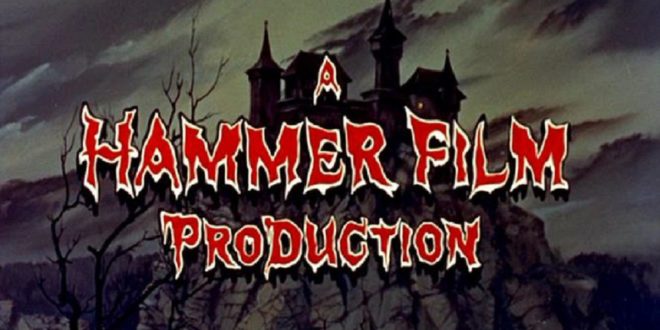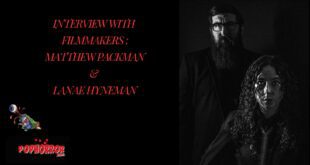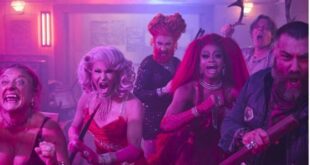It was 58 years ago this weekend that Hammer Films released one of their earliest successes: The Horror of Dracula. The film would go on to inspire more than just a few sequels and helped establish Hammer as premier creators of top-notch cinematic terror.
Hammer Films is a British production company that ruled the horror world through several decades in the 20th Century. Founded in the 1940’s, Hammer was first known as a purveyor of mysteries and crime thrillers. A shift was made after the surprising success of The Quatermass Xperiment (aka The Creeping Unknown) in 1955; the film proved there was great interest among film-goers for monsters and mayhem, and Hammer decided to capitalize almost exclusively on films of this ilk. At the peak of popularity in the 1970’s, they were known for both the quantity and quality of the horror films they produced.
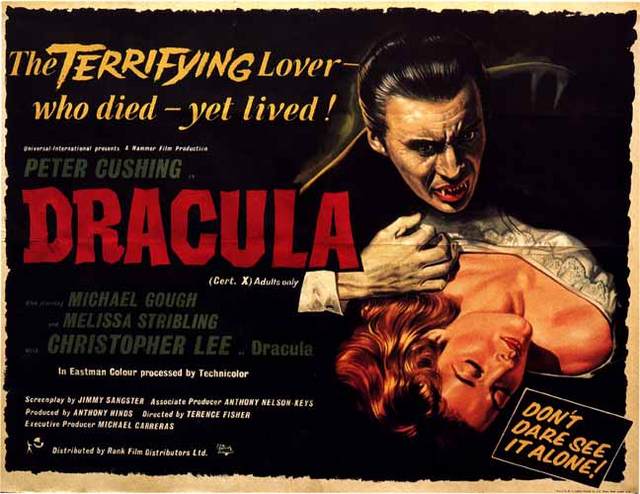
Hammer launched the careers of horror icons Sir Christopher Lee and Peter Cushing; the two actors first worked together on The Curse of Frankenstein (released in 1957). They’d return to the screen in 1958 for The Horror of Dracula: Cushing played a melancholy Van Helsing and Lee played the titular Count, roles that cemented aspects of both characters that would endure into the next millennium.
Sequels to The Curse of Frankenstein included: The Revenge of Frankenstein in 1958, The Evil of Frankenstein in 1964, the raunchy Frankenstein Created Woman in 1967, Frankenstein Must Be Destroyed in 1969, The Horror of Frankenstein in 1970, and (finally) Frankenstein and the Monster from Hell in 1974. Dracula spawned even more films, including: The Brides of Dracula in 1960, Dracula: Prince of Darkness in 1966, Dracula Has Risen from the Grave in 1968, Taste the Blood of Dracula in 1970, Scars of Dracula also in 1970, Countess Dracula in 1971, Dracula A.D. 1972 in 1972 (in which the Count finds himself prowling the discos of London), The Satanic Rites of Dracula (aka Count Dracula and His Vampire Bride) in 1973, and finally The Legend of the 7 Golden Vampires (which pitted the Count against Kung-Fu warriors) in 1974.
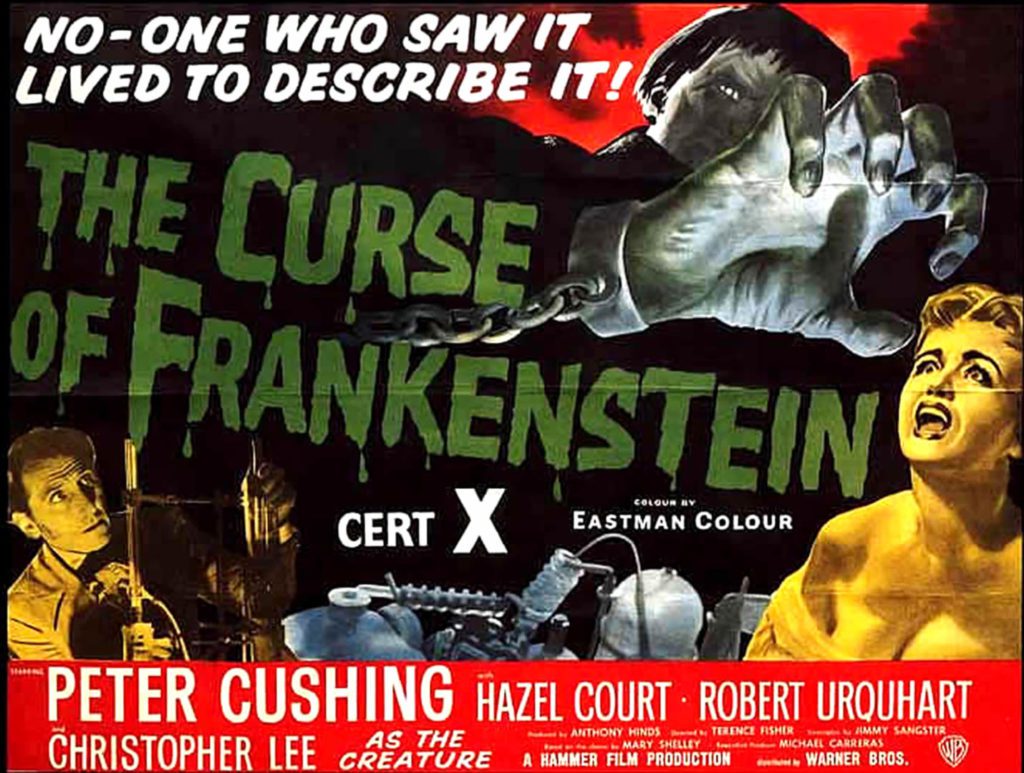
Other classic villains that got the Hammer treatment included: The Mummy, Dr. Jekyll & Mr. Hyde, The Wolfman, The Phantom of the Opera, The Mad Monk Rasputin, The Abominable Snowman, and Jack the Ripper. The company also explored a spectrum of terrors, like: Satanic cults, witches, psychological horror, and even zombies in 1966 (predating George A. Romero’s Night of the Living Dead).
During this period Hammer became known for an instantly identifiable aesthetic that had become their trademark. The fact that most of their films were produced at the same location (Down Place, on the banks of the Thames, later known as Bray Studios), and the recurrence of many of the era’s most famous actors, created an all-encompassing continuity. Hammer was the premier innovator of Gothic horror, establishing tropes that are still widely used in films today.
The company rose to international prominence, but their juggernaut rise to the top would end abruptly in the late 1970’s. The markets had become saturated and completion from American filmmakers was exceptionally stiff. Changes in trends (especially in horror movies) made Hammer’s established formulas obsolete; their well-known style (while still engrossing) began to appear stuffy and antiquated. Hammer’s once lucrative methods of film production were no longer bringing in the returns necessary to maintain operations. They went into an indefinite hiatus after releasing The Lady Vanishes in 1979.
But like Count Dracula or any number of seemingly immortal fiends from their cannon, Hammer Films would return from the grave in the 21st Century. Under the direction of Dutch producer John De Mol, the slumbering production company roared back to life! Their first new production was Beyond the Rave, was a horror serial that ran exclusively on the now defunct MySpaceTV before getting a DVD release in 2008. It took a supernatural lens to London’s underground club scene and featured a cameo from the late Ingrid Pitt, star of Hammer’s The Vampire Lovers and Countess Dracula.
Hammer returned to the big screen in 2010 with the theatrical release of Let Me In, a remake of the Swedish smash Let the Right One In. The fact that the film was set in America and starred American actors was proof the company was willing to extend beyond their established UK geography in favor of a more international appeal.
https://www.youtube.com/watch?v=8h39ikMdei4
Next came The Resident in 2011, a crime thriller starring Hilary Swank and Jeffrey Dean Morgan; Swank plays a recently singled woman living who New York City who worries she’s being stalked. The film featured Hammer mainstay Sir Christopher Lee in an integral supporting role.
Hammer went closer to home with Wake Wood, also released in 2011. It follows an Irish couple who move to the country following the death of their young daughter. The residents of Wake Wood partake in a Pagan ritual that brings the dead back to life, for a short time, to say proper goodbyes to their relatives and loved ones. The mourning couple is willing to risk everything for another chance to hold their daughter.
Hammer went back to their Gothic roots in earnest with The Woman in Black in 2012 and its sequel, The Woman in Black: Angel of Death in 2015. The studio proved there’s still a market for their trademark Gothic aesthetic, and the movies benefited greatly from advances in special FX and filming technologies. While the sequel failed to resonate with audiences, the first, which starred Daniel Radcliffe in one of his very first post Harry Potter roles, was a definite success.
https://www.youtube.com/watch?v=7lReemWmO5o
In 2014, Hammer released The Quiet Ones, a film based on an actual experiment conducted in the early 1970’s. A parapsychology professor from Toronto purported a supernatural phenomenon could be created through sheer force of will.
Wherever Hammer goes from here, they’ve proven themselves a brand name that will always find a following. Whether revisiting their past glories or venturing into uncharted territories, they have a reputation for quality, entertaining horror movies to live up to.
If you can’t get enough of me here at Pop Horror, follow me on Twitter @josh_millican for quality horror articles worthy of your attention.
 PopHorror Let's Get Scared
PopHorror Let's Get Scared
